Our own island tour to the Southern part of Mauritius

Take Off
Jörgen Wennberg
Sun 22 Oct 2017 17:24
Sunday 22 of October we took our hired car and made a tour of the island on our own. We had throughly investigated what to do and came to a conclusion that most of the activities where at the South of the island. This happened to be very convenient as we had booked a riding session at Haras de Morne, the Southern tip of Mauritius. We found this stable through a French-British couple, Alain and Sonya, we met in Denarau, Fiji. This is more than 4 months ago! They had mentioned a close friend to them managing a horse riding center in Mauritius and now here we are 4 months later. Alex and Inez as well as Pär and Jörgen were really excited about this experience! 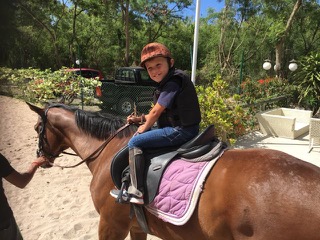 The stable was not far away from the beach and only a few minutes later we realise that we will be riding along the beach, together with all the kite surfers! Wow how cool! 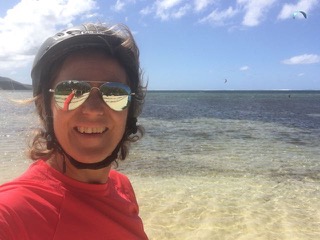 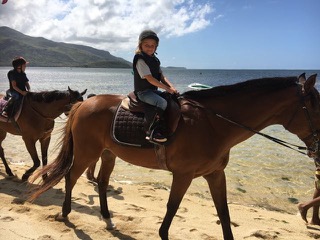 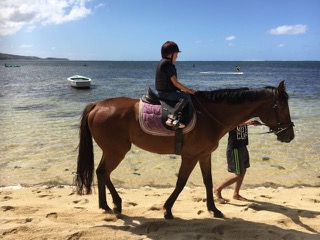 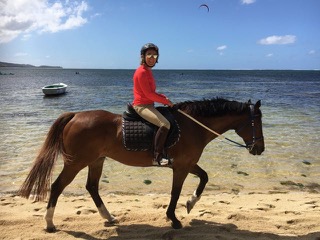   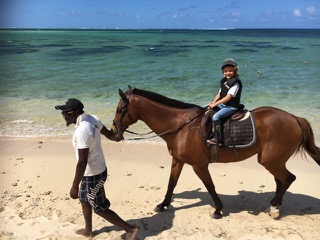  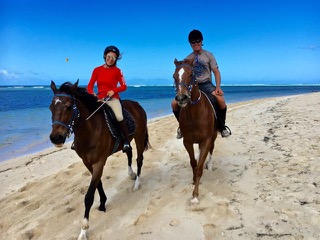 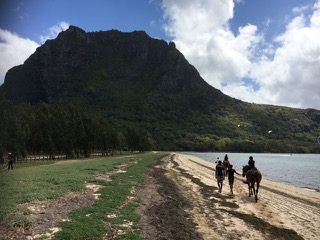  Pär and Jörgen were totally overjoyed by this riding experience, even more than Alex and Inez. It’s easy to please bigger kids too! 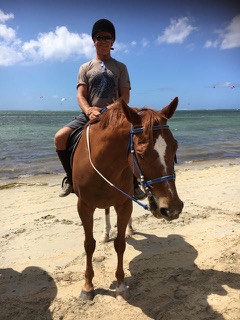  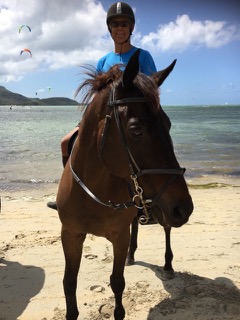 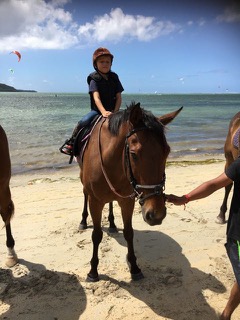 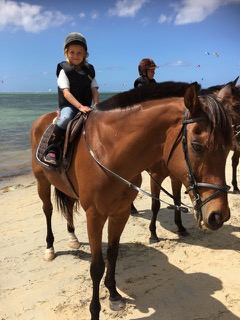 Thank you Mum and Dad! 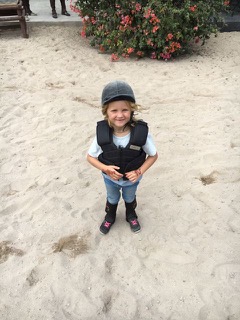 As we were at the foot of Le Morne Brabant we took the chance to pay it a visit. The Southern part of Mauritius with the rock Le Morne Brabant: 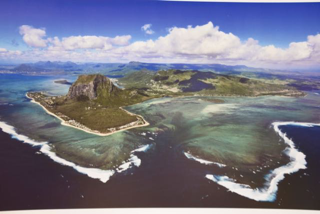 Le Morne Cultural Landscape was proclaimed as a National Heritage and inscribed to the World Heritage List in 2006. It is an exceptional testimony to resistance to slavery, marring and the quest of freedom. The mountain was used as a fortress. Escaped slaves climbed the risky landscape and steep rock formations, making their way through a deep and narrow gap in the cliffs - the V shape-gap, to reach the plateau at the top. They converted its caves into permanent shelters and took refuge in the thick vegetation to avoid detection. The landscape has many assets that are intertwined with its natural attributes. The trail to the mountain passed through the former village of Trou Chenile. This village was considered to be the cradle of settlement of the South West region of Mauritius, where the descendants of slaves continued to live after the abolition of slavery in 1835. All these characteristics make up the rich layer of history of Le Morne Cultural Landscape UNESCO World Heritage Site. The image of Le Morne as a symbol of freedom and resistance has dominated the history of the island. The mountain retains a prominent position in the cultural and memorial landscape of Mauritians. We followed the trail up the mountain and within a few 100 meters we already could enjoy a splendid over the beach…. the beach where we just had spent time riding with the kite surfers! From above it was amazing to see all the hundreds and hundreds of kite surfers sharing the wind and perfect sea conditions.   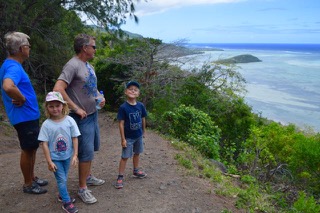 We came to a point where we decided to not go further. We did not have the appropriate shoes and with Alex and Inez we did not want to take any risk. However we stil enjoy a splendid view of the South West coast of Mauritius. 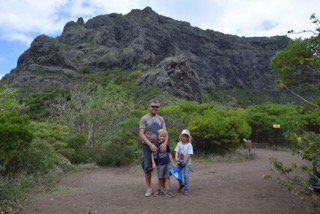   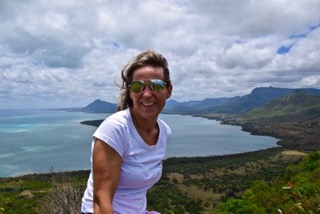 The view over the reef was as amazing as like it would have a postcard! Down there we could see all the mini-spots being kite surfers. 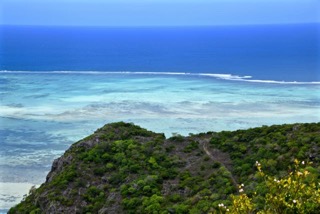 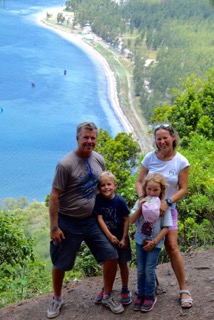 For lunch we found this wonderful little restaurant at the foot of Le Morne. 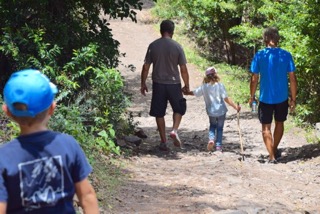  We drove now more further North to the next very typical Mauritian attraction : "Terre des 7 couleurs" which is "The 7 coloured earth”. The “7 Coloured Earth” dunes, which can reach up to 15 m thick, contain traces of ancient activity of geoclimatic events. The basalt from the intermediate period lava flow (3-1,7 millions years) has been leached by the hot and humid climate, leading to gullied clay. This profound and ultimate decomposition has left on-site iron and aluminium oxides. Iron and aluminium repel each other and gather spontaneously in colourful stripes. The ferric oxide gives the land shades ranging from rod to brown. The aluminium gives the land shades ranging from blue to violet-blue. The leaching of the basalt has resulted in depleting the soil from nutrients that are necessary for vegetation to grow. This is why no plants will ever grow on the dunes. The various components of magmatic rocks are demonstrated in the astonishing assemblage of the 23 nuances of volcanic ashes coming from the smaller crater of Bassin Blanc. This is our first view over the 7 coloured earth. We were amazed...  … then the sun came out: we were blown away!   We could stand here for hours just contemplating. As the day was partially cloudy the sun came out on and off and it was like the landscape was living its own live changing colours and even shape following the sun’s shade. 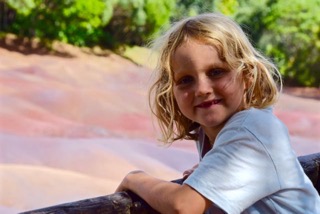    Nearby was the sanctuary for the giant tortoises. We admit that we did not spend so much time with them as we had seen in the wild in Galapagos.  Driving out the 7 coloured each we passed by the Cascade Chamarel.  We continued North driving another road back to Port Louis through this beautiful landscape. 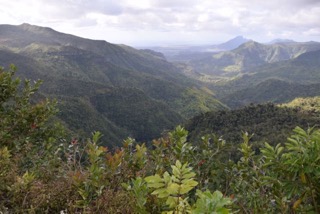 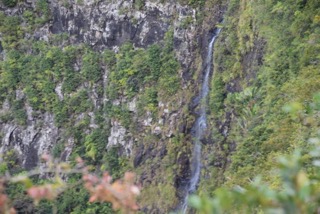 Our last stop of the day was Ganga Talao. We had no idea what to expect, just that we knew it was some sort of temple. What was the most impressive about this place apart from the two huge (big, big, big) statues in front of the temple was the road we drove on. The road went on and on and on and was 3 lanes wide. Beside the 3 lanes was a footh path nearly as wide as the 3 driving lanes. This can only explain that this place has to be some sort of pilgrim and that some time of the year many many thousands and thousands of people make their way to this place. It was rather amazing and quite inquisitive to see. 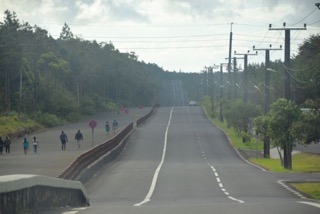  As for the statues they were impressive too ot see. You can tell by the small people standing at the foot of the statue how tall the statue is.  We continued our way to the temple and by the road and the statues we expected an ever bigger temple. Imagine our surprise when we saw a lake and quite tiny temple by the lake. We seriously drove further to see if we had not missed something. No, this was the temple. We understood later on that the sacred place is not the temple, however the lake. Ganga Talao (commonly known as Grand Bassin) is a crater lake situated in a secluded mountain area in the district of Savanne, deep in the heart of Mauritius. It is about 1800 feet above sea level. The first group of pilgrims who went to Ganga Talao were from the village of Triolet and it was led by Pandit Giri Gossayne from Terre Rouge in 1898. It is considered the most sacred Hindu place in Mauritius. The Sagar Shiv Mandiv is located on the bank of the lake and is dedicated to Lord Shiva. There are temples dedicated to other Gods including Lord Hanuman, Goddess Ganga, and Lord Ganesh along the Grand Bassin. During Shivatri, many pilgrims in Mauritius walk bare feet from their homes to the lake.   Alex were not as impressed by this holy place and were happy to just have some space to run their legs off.   At the entrance of the temple we found this beautiful statues. Would have been interesting to know what they represent.  Driving back to Port Louis we passed by a few Hindu temples. They are amazingly beautiful and you can watch them for hours contemplating every detail. 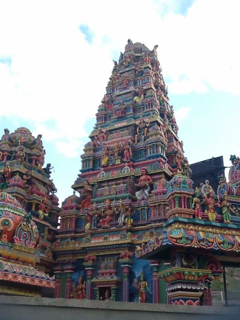 Here we are singing a birthday video to Louise’s godson Leo in France.  |